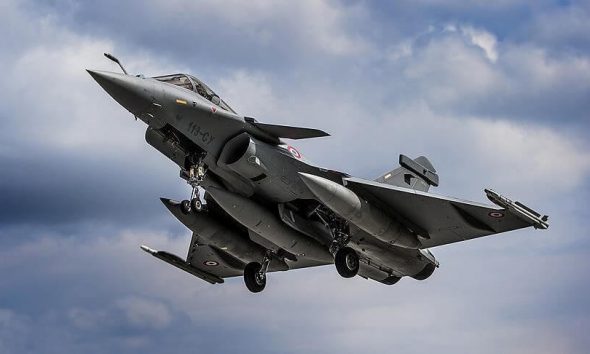While India is celebrating the arrival of its Rafale jets, military experts have not only questioned its capabilities against US aircraft but also raised questions why the Rafale jets failed to compete in the international arms markets and got dumped by a majority of nations?
Dassault’s Rafale was not India’s only choice as various other global firms expressed interest in the MMRCA tender. Six renowned aircraft manufacturers competed to bag the contract of 126 jets, which was hailed to be the largest-ever defence acquisition deal of India.The initial bidders were Lockheed Martin’s F-16s, Boeing’s F/A-18s, Eurofighter Typhoon, Russia’s MiG-35, Sweden’s Saab’s Gripen and Dassault’s Rafale.
All aircraft were tested by the IAF and after careful analysis on the bids, two of them — Eurofighter Typhoon and Dassault Rafale — were shortlisted.Dassault received the contract to provide 126 fighter jets as it was the lowest bidder and the aircraft was said to be easy to maintain. After Rafale won the contract, the Indian side and Dassault started negotiations in 2012. Though the initial plan was to buy 126 jets, India scaled it down to 36, that too in fly-away condition.
No Buyers For Rafale Jets?
Despite boasting of awe-inspiring capabilities and selected by India after a mammoth testing & bidding process, the French origin jets didn’t see many buyers. Other than France and India, only Qatar and Egypt are using Rafale jets and that too in very limited numbers.
As reported earlier by EurAsian Times, Russian aviation experts had claimed that Rafale jets would have been useless against the Chinese Airforce (PLAAF). The maximum speed of the Rafale jet is about Mach 1.8 compared to Chinese J-16s at Mach 2.2.
The Rafale’s practical ceiling is also lower than the J-16s. Even in engine thrust, the Chinese J-16s aka Russian Su-35s are far superior to the French combat aircraft. Even if the Indian Air Force (IAF) was to deploy all 36 of its newly acquired jets, the technical superiority would still be on the side of China, claimed the Russian expert.The Rafale is one of the most expensive aircraft in the international market. India’s deal of 36 jets is worth Rs. 60,000 crores. Experts argue that the high cost is the result of many reasons including general inefficiency in the country’s defence sector, along with the small scale on which the Rafale is being produced in comparison to rival fighters such as the F-18, MiG-29 or F-35 due to which Rafale has not benefitted from economies of scale. This has contributed to its poor performance in the international markets.
Analysts believe that a major hindrance to the Rafale’s success is that it combines a high cost with a very light and unspecialised airframe, meaning that for countries seeking out a high-end fighter, they will turn to look towards something heavier and with more capabilities like the F-15 or Su-35, while for those seeking a cheap medium or lightweight fighter the F-16V, F-18E or MiG-35 would be more cost-effective.
South Korea and Singapore selected the powerful F-15 over Rafale in the 2000s. In 2015, Egypt purchased 24 of those jets – with an option for 12 more – under a wider arms agreement with France.
The following year, in 2016, the two sides entered into a dialogue with Egypt possibly exercising that option, or even expanding the order up to 24 jets. However, even with high-level dialogue between Egyptian President Abdel Fattah el-Sisi and French President Emmanuel Macron, Cairo and Paris didn’t finalise the deal. Instead, Egypt inked a deal with Russia to purchase “over two dozen” Su-35 fighter jets.
“Indian media is celebrating the arrival of five Rafales as if they won a war against China. If Rafale is so good, why Oman, Korea, Singapore, Libya, Kuwait, Canada, Brazil, Belgium, UAE, Switzerland, Malaysia refused to buy it. Besides India, only Qatar & Egypt have bought it,” tweeted Ashok Swain, Professor of Peace and Conflict Research, UNESCO Chair of International Water Cooperation.
Rafale’s third buyer, India, previously proposed to acquire 126 jets under Make in India and not 36. However, it took five years for even the first five jets to arrive in India after Prime Minister Narendra Modi announced it in April 2015 during his trip to France.
According to Snehesh Alex Philip’s opinion piece in ThePrint, beneath the celebration of the arrival of Rafale jets, lies the harsh reality of India’s painfully slow defence purchases. The Rafale deal and a plethora of procurement, now being done under the emergency clause in the wake of tensions at the Line of Actual Control (LAC), exposes the malaise that continues to shadow India’s defence procurement and planning. “Merely having a large standing Army or an Air Force with aircraft flying on an extended lease of life and without much use against modern weaponry of the enemy, cannot be India’s answer,” he wrote.
According to analysts, despite heavy marketing by the makers of Rafale, France’s relatively small and inefficient defence sector seems to have met its limit with the fighter program. The small production lines are unable to produce the aircraft quickly or efficiently and the French budget for research and development is smaller in contrast to the US or Russia.
The aircraft is priced very steeply and most nations prefer to buy US jets not only because of the technical superiority but also to please the Americans instead of the French. The Rafales have seemingly lost the fight in the international market, despite boasting of excellent qualities.


























































































